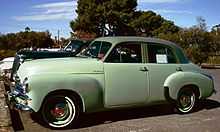Holden FJ
| Holden FJ | |
|---|---|
 Holden FJ Special Sedan | |
| Overview | |
| Manufacturer | Holden |
| Production | 1953–1956 |
| Assembly | Adelaide, Sydney, Melbourne, Brisbane, and Perth, Australia |
| Body and chassis | |
| Class | Mid-size car |
| Body style |
4-door sedan 2-door coupe utility 2-door panel van |
| Layout | FR layout |
| Powertrain | |
| Engine | 2.2 L (132.5 cu in) I6 |
| Transmission | 3-speed manual |
| Dimensions | |
| Wheelbase | 2,620 mm (103 in)[1] |
| Length | 4,401 mm (173.3 in)[2] |
| Width | 1,702 mm (67.0 in)[2] |
| Height | 1,581 mm (62.2 in)[2] |
| Curb weight | 1,018 kg (2,244 lb)[2] |
| Chronology | |
| Predecessor | Holden 48-215 |
| Successor | Holden FE |
The Holden FJ series is a range of motor vehicles which was produced in Australia by General Motors-Holden’s from 1953 to 1957. The FJ was the second model of an "all Australian car" manufactured by Holden and was based upon the established 48-215 series, commonly referred to as the “FX”. The sedan, in Standard, Business and Special trim levels,[3] and a coupe utility were announced in October 1953 and were followed by a Panel van derivative in December of that year.[4] A wagon prototype was built but the bodystyle was not put into production.[5] In 1954, Holden's first exports began with sales of the FJ in New Zealand.[6]
The FJ, of monocoque construction, broadly followed the silhouette of its predecessor, but featured a bolder horizontal styled front grille, along with comfort and decoration upgrades in a new sedan model named the 'Holden Special'.
Originally specified as 60 bhp (45 kW) achieved at 3,800 rpm,[2] the claimed maximum power output from the six-cylinder engine was increased to 65 bhp (48 kW) achieved at 4,000 rpm.
In 1955 the car underwent a mild interior facelift for the Holden Special sedan, along with a variation in paint and trim options. The FJ series was progressively replaced by models from the Holden FE series from July 1956 to May 1957[7] with a total of 169,969 examples produced.[8]
There are nearly 20 specific FX-FJ Holden Car Clubs of Australia with members committed to preserving these iconic Holdens. These clubs organise a national gathering for FX-FJ Holden enthusiasts every second year.
.JPG) Holden FJ Standard |
 Holden FJ Special |
 Holden FJ Panel Van in original Royal Mail livery |
.jpg) Holden FJ Coupe Utility |
 Holden FJ engine |
In popular culture
In the 1976 Australian film, Oz, an FJ features as the pride and joy of the character Greaseball, the heartless mechanic. Its Victorian registration number plate is FJ-056 (white characters on black plate) and the car is dark blue. While he is bragging to his female passenger, Dorothy, about the modifications he made to the 138 cubic-inch engine, it expires in a cloud of smoke. Lifting the bonnet and peering into the smoke, Greaseball exclaims, "Jesus, it’s stuffed!".[9]
In the 1980s Australian television drama series A Country Practice, Brendan and Molly Jones own an FJ. Its New South Wales registration number plate is DBV-862 (black characters on yellow plate) and the car is light grey.[10]
Efijy concept car
Holden paid homage to the FJ with a 21st-century version of the iconic car, the Efijy.
References
| Wikimedia Commons has media related to Holden FJ. |
- ↑ Gloor, Roger (1. Auflage 2007). Alle Autos der 50er Jahre 1945 - 1960. Stuttgart: Motorbuch Verlag. ISBN 978-3-613-02808-1.
- ↑ 2.0 2.1 2.2 2.3 2.4 "Holden FJ Technical Specifications". Unique Cars and Parts. Retrieved 2009-11-30.
- ↑ Davis, Tony; Kennedy, Alistair; Kennedy, Ewan (February 2007). "The Holden Heritage - 13th Edition (Part One)" (PDF). GM Holden. pp. 40–41. Archived from the original on 15 September 2010.
- ↑ Norm Darwin, 100 Years of GM in Australia, 2002, page 225.
- ↑ Tony Davis, Aussie Cars, 1987, page 67
- ↑ Tuckey, Bill (1999). Commodore Lion King: Celebrating 21 Years. Middle Park, Victoria: Quill Visual Communication. p. 120. ISBN 0-646-38231-4. OCLC 222534995.
- ↑ Norm Darwin, 100 Years of GM in Australia, 2002, page 228.
- ↑ Tony Davis, Aussie Cars, 1987, page 67.
- ↑ DVD "OZ A ROCK 'N' ROLL ROAD MOVIE"
- ↑ DVD "A Country Practice UNFORGETTABLE MOMENTS SEASONS 1 – 5"
External links
- www.fxfjholden.com - The best place on the net for FX and FJ Holden's
- FJ Holden at the National Museum of Australia
- FJ Holden with pics and stats
| Holden, a marque of General Motors, automobile timeline, 1948–present |
|---|
| List of Holden vehicles † HQ–WB Statesmans not marketed under the "Holden" brand, but rather the separate "Statesman" brand. |